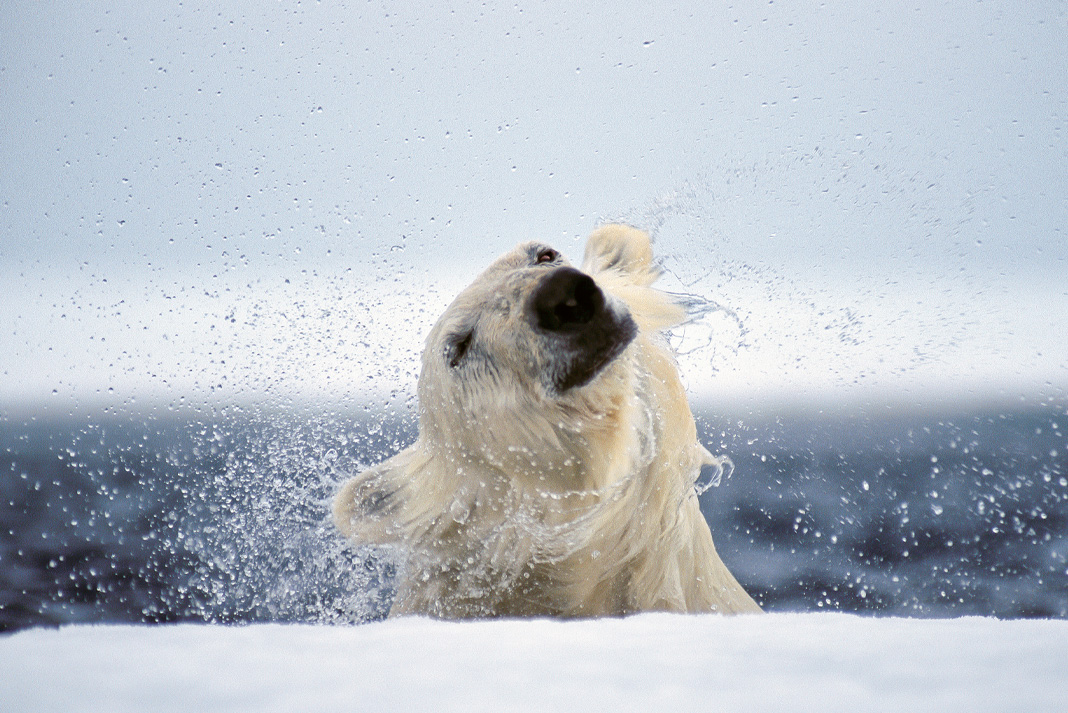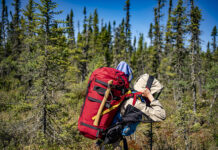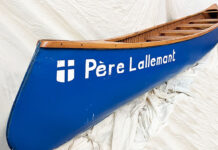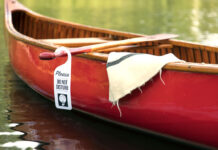My two main passions are paddling and the North. Over the last four years, the North has been my main focus while working on a book about polar bears. Paddling has taken a back seat—if you don’t count daily toots around the lake with the dogs at home—but there’s one story connecting bears and boats still keeping me up at night.
Five of us were on an exploratory sea kayak journey in Wager Bay, high up on the western shore of Hudson Bay. We were investigating the recreational potential of what would become Ukkusiksalik National Park in Nunavut. In addition to its sheltered waters and rich cultural, historical, geological and geographical heritage, it is captivating for its big white bears. When the ice of Hudson Bay melts, Nanook heads to the shores of Wager Bay for the summer fast. On average, scientists estimated something like 80 bears per 100 kilometers of shoreline—which is a lot of bears.
We traveled with a group of Inuit from Arviat and Repulse Bay, led by the late Louis Pilakapsi, who was there to site a naturalist’s lodge he and others were looking to start in conjunction with the creation of the national park. Louis and company traveled in open motorized canoes, camped in wall tents and were actively hunting as we made our way around the coast. As long as we camped near them, the bear threat was low.

When we split the group and went our separate ways for days at a time, things got interesting. Heading out onto the treeless Arctic tundra to answer nature’s call required two people—one with TP, one with a gun. As long as we stayed together on and off the water, we were reasonably safe. It was when the togetherness of a small herd of kayaks and kayakers fell apart, things turned scary.
I happened to be in a solo Feathercraft kayak the day the others pulled out their parasails to take advantage of a brisk following wind. They had sail assist, I did not. Within minutes, I was alone. All was going swimmingly—I was contemplating life in general, daydreaming and admiring the colors of the other two boats under sail against the blue of the Arctic sky as they got smaller and smaller. Life, I eventually concluded, was perfect.
It was about then everything clicked into slow motion. Paddling a few hundred feet offshore, I turned left and spied a big male polar bear paralleling me along the shore, step for stroke, stroke for step.
The first shot of adrenalin perfused every muscle in my body. My first instinct was to turn away and increase the distance between us. Until I shot a furtive glance over my shoulder just in time to see the bear drop into the water and start to swim.
My next instinct was to pick up the pace, but details from papers I read at school reminded me polar bears have been sighted 50 miles from land. They can swim at six miles an hour almost indefinitely, certainly for far longer than I could paddle at top speed.
Bear in the water. Paddler on the water. Distance between them diminishing. Me flailing, inside and out.
In the next moments, which stretch to eternity in the memory of this encounter, many things flashed over and through my brain. This bear has likely not eaten anything substantial since it came ashore, maybe a month ago. This is a hungry bear. What kind of personality does this bear have? Do bears even have personalities? Has Myers Briggs even thought of that? Has this bear seen other kayakers? Certainly, this being Inuit territory. Has it eaten other kayakers?
“Polar bears can swim at six miles an hour almost indefinitely,
certainly for far longer than I could paddle at top speed.”
My kayak’s skin was soft and drum-like over its frame. Not a great armor to fend off a hungry bear. If I honked on the Fox 40 whistle on my PFD zipper, would the others even catch a sound on the wind? Would they even be interested in paddling upwind to see why I wasn’t coming along?
What a spectacular place to die. Or something like that.
It was like the totality of a feature-length movie starring me and a big male polar bear ripped through my consciousness in a few fluttering beats of my adventuring heart.
Then, just as effortlessly as it had slid into the water, the bear turned back toward shore, hauled itself out onto the rocks with practiced ease, shook in a magnificent cascade of spray, and trundled on up the bank.
Today was not the last day of my natural life.
With a fuzzy and electric post-car-crash adrenalin hangover ebbing every joule of energy from my body, I sat in the kayak. Breathing. Just breathing. And watching, as the whiteness of the moving, shrinking bear contrasted the tundra summer greens. Scanning back along the shore, where this crazy vignette had begun, I noticed a small cliff rising out of the water. And with it—ding!—crystallized a completely different scenario.
The bear is ambling along the beach. It comes upon the little cliff. Instead of wasting energy on lumbering up to higher ground and working his way over the cliff and dropping back down to the beach, he simply flopped into the water. He swam around the obstacle before continuing along the shore. In Latin, polar bears are Ursus maritimus, sea bears, bears who are as comfortable in the water as on land or ice—duh. Whether he knew or cared I was there at all, that bear had no interest in the drama going on in my head. The bear was just doing his bear thing.
We humans aren’t the center of anything except our own reflections. We don’t figure at all in the universe of the polar bear, until of course, we stroll into their home territories or alter the climate to the point the bear’s winter seal hunt gets critically shortened because the sea ice is melting. Coming ashore with less fat to sustain polar bears through the summer fast, that’s an increasing problem too.
All kinds of other changes and shifting circumstances are happening for all living beings, in the North, particularly, as a result of climate change. What’s a bear to do? Kayakers as an emergency energy source could be on the table.
James Raffan is the former executive director of the Canadian Canoe Museum. His new book, Ice Walker, from Simon and Schuster, launches September 29, 2020.
This article was first published inPaddling MagazineIssue 62. Subscribe toPaddling Magazine’s print and digital editions here , or browse the archives here.
The average male polar bear weighs between 775 to 1,200 pounds (351 to 544 kilograms). See more of Paul Nicklen’s limited edition fine art collection at paulnicklen.com/fine-art. | Photo: Paul Nicklen








